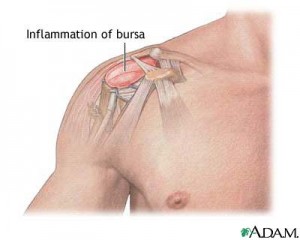What is Shoulder Bursitis?
A bursa is a tiny fluid-filled sac that functions as a gliding surface to reduce friction between tissues of the body. The plural of bursa is bursae. There are 160 bursae in the body. The major bursae are located adjacent to the tendons near the large joints, such as the shoulders, elbows, hips, and knees.
Bursitis is inflammation of a bursa. When injury or inflammation of a bursa around the shoulder joint occurs, shoulder bursitis is present.
How does a bursa becomes inflamed?
A bursa can become inflamed from injury, infection (rare in the shoulder), or an underlying rheumatic condition. Examples include infection of the bursa in front of the knee from a knee scraping on asphalt (septic prepatellar bursitis), inflammation of the elbow bursa from gout crystals (gouty olecranon bursitis), or injury as subtle as lifting a bag of groceries into the car, which could inflame the shoulder bursa (shoulder bursitis).
What are the symptoms of shoulder bursitis? How is it Diagnose?
Bursitis is typically identified by localized pain or swelling, tenderness, and pain with motion of the tissues in the affected area. X-ray testing can sometimes detect calcifications in the bursa when bursitis has been chronic or recurrent. MRI scanning (magnetic resonance imaging) can also define bursitis.
How is shoulder bursitis treated?
The treatment of any form of bursitis depends on whether or not it involves infection. Infection of a shoulder bursa is uncommon, and bursitis that develops there is usually from injury. Bursitis that is not infected (from injury or an underlying rheumatic disease) can be treated with ice compresses, rest, and antiinflammatory and pain medications. Occasionally, it requires aspiration of the bursa fluid. This procedure involves removal of the fluid with a needle and syringe under sterile conditions and can be performed in the doctor’s office. Sometimes the fluid is sent to the laboratory for further analysis. Noninfectious shoulder bursitis can also be treated with an injection of cortisone medication into the swollen bursa. This is sometimes done at the same time as the aspiration procedure. Physical therapy can sometimes be used to aid the recovery from bursitis, especially when it is accompanied by a frozen shoulder.
Infectious (septic) bursitis, which again is uncommon in the shoulder, requires even further evaluation and aggressive treatment. The bursal fluid can be examined in the laboratory to identify the microbes causing the infection. Septic bursitis requires antibiotic therapy, sometimes intravenously. Repeated aspiration of the inflamed fluid may be required. Surgical drainage and removal of the infected bursa sac (bursectomy) may also be necessary. Generally, the adjacent joint functions normally after the surgical wound heals






